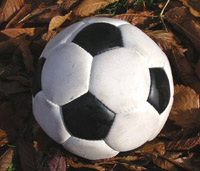Drawing the Football :Understanding the Structure
How can all this information help us to draw a football?
Well if you look at a football you will see that although the hexagon (white) patches can be side by side we never see two pentagon patches touching each other (pentagons never share an edge).
In fact each pentagon (black patch) is separated from the next by hexagons. If you consider the symmetry and look carefully at a football you will see that every corner in the football resides in a pentagon (non are in a hexagon alone). As there are 12 pentagons and each pentagon has five corners then there must be 12 x 5 = 60 corners in the football.
Euler's Law
 A famous mathematician Euler discovered a simple formula that accounts for the number of faces (F), corners (C) and the number of edges (E) in simple shapes:
A famous mathematician Euler discovered a simple formula that accounts for the number of faces (F), corners (C) and the number of edges (E) in simple shapes:
He found that F + C - E = 2 for many shapes.
(where F, C and E are the numbers of face, corners and edges)
For example take a cube (die) it has 6 faces, 8 corners and 12 edges so we get 6 + 8 - 12 = 2, which works.
Now in a football we have 60 Corners and each corner has three edges (which themselves go between two corners). This means there are 3/2 edges for each corner giving a total for the whole ball of 60 x 3/2 = 90 edges.
Now we know we have:
C = 60, E = 90, F = number of Pentagons + hexagons = 12 + H
putting these in to C + F - E = 2 we can use it to predict the number of hexagons (H):
C + F - E = 2
60 + (12 + H) - 90 = 2
which on rearranging gives:
H = 2 + 90 - 12 - 60 =20 hexagons on the football.
Pentagons
The pentagons are very important in the structure as we find that groups of hexagons can only be flat - just like a tiled floor (this is why the three pictures at the start of article look flat - they would be in real life). As each pentagon is added the shape curves up a little more. When 12 pentagons are included the ball completely closes up. When we draw the structure we need to take into consideration this curving.
Summary of the Football - The Truncated Icosahedron
So from what we have learnt the football is a truncated Icosahedron having:
12 pentagons (five sided patches),
20 hexagons (six sided patches),
60 corners,
90 edges,
and although the hexagons can lie side by side no pentagons touch each other in this way (non share an edge).
This content has been re-published with permission from SEED. Copyright © 2025 Schlumberger Excellence in Education Development (SEED), Inc.

